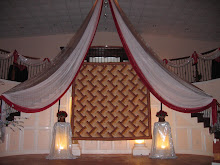I have a few unfinished projects.
And this is the biggest, most unfinished one.
I first purchased yards and yards of red and blue flannels probably 5 years ago. I wanted to make a nice snuggly quilt for my hubby. And, somehow, I wanted it to be a surprise.
I had no pattern in mind and was making this up as I went.
So, it took a while to actually start. I started by cutting squares. Lots of squares.
 Then I decided to add some regular cotton fabric in between the squares to help square up the flimsy flannel. Enter the creamy, brown paisley. Sewing the top together didn't take too long once I started. In the meantime, I had made another flannel quilt and quilted it on my machine and didn't like how that had gone. The flannel had a mind of its own and there was lots of frustrated unpicking. So, I decided to hand quilt it.
Then I decided to add some regular cotton fabric in between the squares to help square up the flimsy flannel. Enter the creamy, brown paisley. Sewing the top together didn't take too long once I started. In the meantime, I had made another flannel quilt and quilted it on my machine and didn't like how that had gone. The flannel had a mind of its own and there was lots of frustrated unpicking. So, I decided to hand quilt it. Hand quilting's nicer, anyway, right? More time, sacrifice, and love involved, right?
 I couldn't hide the surprise anymore because my hubby was going to see it on the frames. So I gave him an unfinished quilt top one year for Valentine's day. Two years ago.
I couldn't hide the surprise anymore because my hubby was going to see it on the frames. So I gave him an unfinished quilt top one year for Valentine's day. Two years ago. It's still on the frames, leaning against the wall in the sunroom. On those rare days when I get out there to work on it, I have to dust it off. Pretty pathetic.
It's still on the frames, leaning against the wall in the sunroom. On those rare days when I get out there to work on it, I have to dust it off. Pretty pathetic. 


































